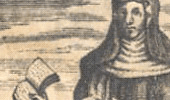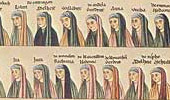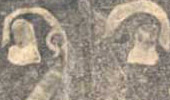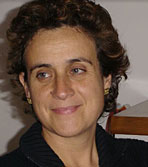La differece of being woman
Research and Teaching of History
Area: Essays
Women of Light and Founding Mothers Núria Jornet Benito.
Núria Jornet Benito.
Introduction
Throughout history there appear women who, in the eyes of their contemporaries, act as models of saintliness, exuding an aura of light that makes them worthy of worship that is not necessarily sanctioned by the Catholic Church. They are women that become charismatic figures within their community —in their group or in their town— and they carry out prophetic, healing functions or are mediators of divinity.
Throughout history there has also existed the human need to find in life and in the world these “centres” of light. Witness to this in present-day western society, criticised for its materialism and extreme secularisation, are the constant personal searches, that connect us to transcendence: psychoanalysis and various therapies, sects and groups of self-knowledge and spiritual growth, leadership of gurus, etc.
In the Middle Ages, historiography has confirmed the strong presence of these women, who are inscribed within a more general context of feminine protagonism in spiritual and religious movements, in various forms and profiles: recluses or “walled-in” who take on the hermit ideal in the urban medium, who advise and listen; beguines or laywomen who continue with the active aspect, charity work of the evangelical Martha in the medieval hospitals; tertiaries connected to the mendicant orders that materialise the wishes of laypeople to participate in the religious phenomenon; “saint” abbesses linked to the new orders born of the mendicant spirituality (Clares, Dominicans), etc. Some of them were to have an official place in history, being models of sanctity of some monastic order and obtaining in certain cases ecclesiastical canonisation; of others, we know the history of their life and their spiritual journey through the “Vitae” that those who were their confessors or also their companions or followers wrote; of some more there only remain signs in local cults or devotional practices, epigraphic testimonies and documents or legends. On the other hand, in other cases they took on an aspect that fell outside of the social framework, being considered to be heretics and later, witches.
Inés de Peranda and Clara de Porta are placed within this context. Still remembered by the monastic community of which they are considered mothers and founders, the present-day Benedictine monastery of San Benito of Montserrat; present on the tomb presiding over the cloister, in the documents of the archive and in the legend of their arrival in Barcelona, which makes them nieces of the Santa Clara herself and in the framework of the wish and founding desire of the Italian saint. Also present from the thirteenth century in the local devotion, and at the beginning of the twentieth century in the process of beatification that took place in the Barcelona Curia and that did not have a successful outcome.
Inés and Clara were in their time “women of light”. Light that made them worthy of a continuing practice of devotion and made them into “saints”; and, on another level, were, in their role as mothers and founders of a group of women, the essential characters in the construction of feminine historical memory.
Inés de Peranda and Clara de Porta, the Founding Work
The monastery of Sant Antoni and Santa Clara was the first monastic community of the second Franciscan order in Catalunya. As usually happens concerning the origins of many monasteries, and more so in a period such as the medieval one when many of the communities are fruit of the institutionalisation of previous religious spaces that were not very formalised or of non-regulated spiritual practices, it is difficult to place the date of their founding. The two historical sources that make it possible for us to know of this history differ in dates and people. Thus, the account of a legendary nature that seems to have taken shape within the monastery itself from the beginnings of the seventeenth century, from the hand of the then prioress and shortly afterwards abbess Dorotea Çarovira (1637-1644), affirms that the community is fruit of the direct wish of Saint Clare, who in the year 1233 would have sent two disciples to our lands, linked to her through different degrees of kinship, in order to found a community of Clares. What would become from then on a legend that would be repeated and accepted by a good part of the Franciscan and Benedictine chroniclers, therefore connects the Barcelona monastery to the spiritual project led by the Italian saint herself and her founding wish.
The archive of the monastery and the conserved documents situate the origin of the monastery around 1236, date of the document sent by the Pope Gregorio IX to the faithful of the diocese of Barcelona, urging them to help with charity a group of pious women who want to found a community of “poor recluse nuns of San Damián” in the city. The group, called “sorum penitentum” in the document, is made up of a total of 12 women, of whom we know the name of two, who are those who addressed themselves to the pope: Berenguera d’Antic and Guillerma de Polinyà. It also seems that the group had land on which to build the monastery and that the contribution asked for in reality would help to finish some space or already begun project (“adjute opus consumare”). An element that makes us think of the existence of a previous pious group or association of “mulieres religiosae”, who have approached the new spiritual currents, especially the pauper and evangelical ideals promoted by the mendicant orders and that finally would become part of the women’s Franciscan framework.
Viterbo. 1236, 18th February. Butlla de Gregori IX als ciutadans de Barcelona perquè contribueixin amb les seves almoines a l’edificació del monestir. MSC (Monastery of Santa Clara), Collection of parchments, no. 179.
Certainly the epic and miraculous character of the legend, on describing the arrival of the two women in a small boat without oars, after suffering a shipwreck, offers few doubts as to its veracity. Even more so when we discover that the resource of a primitive and legendary feminine intervention, personified in the disciples and/or family members sent by Santa Clara herself appears both in the Castilian-Leonese and Andalusian areas of the Iberian Peninsula, as well as in other areas of Europe. However, rather than certifying or not its veracity, what we should perhaps emphasize is that, as Milagros Rivera affirms, “the legend picks up on a known truth that other forms of the transmission of knowledge or of historical memory are not capable of picking up on”. In the case of the Barcelona foundation, the legendary chronicle does no more than put centre stage visible to historical interpretation the relationships between some women who shared the same spiritual longing; they were “touched” by the charisma of Saint Francis and they followed the feminine project sketched out by Saint Clare very closely, not without difficulties.
Mª del Mar Graña Cid, 1994.
Milagros Rivera, 1999, p.110.
The link with Saint Clare is made evident even in the personal journey of the abbess Inés, who wanted to renounce her abbacy as Clare of Assisi had done. The letter that Pope Alejandro IV sent her in the year 1258 is significant concerning the prestige and the authority that the abbess of San Antonio enjoyed and in it the Pope lauds her virtues and exhorts her to continue in her post.
At the present time we do not know if any direct contact was established between Clare of Assisi and the abbess Inés, excepting this desire to emulate the Italian Saint by Inés and the familiar and teacher-disciple connection that the founding legend of the monastery visualises. Contrarily, we do know of the epistolary relationship that Clare of Assisi maintained with other founding abbess saints of the Order of San Damián, and that has left writings of unquestionable beauty: letter addressed to Inés de Bohemia, founder of the monastery of Prague, and with Ermentrudis de Brujas, del de Brujas. To find out more: Escritos de santa Clara. Madrid: Biblioteca de Autores Cristianos, 1970. Escrits de Sant Francesc i Santa Clara. Barcelona: La Hormiga de Oro, 1998.
Central fragment of the setter sent by the Pope Alexander IV to the abbess of the monastery of San Antonio de Barcelona, Inés (1258, July, 27). MSC, Collection of parchments, no. 526. [Translation in Castilian of the Catalan translation of the original text in Latin].
"[...] with so much pleasure those things stimulate you through which those of the heavenly fatherland are achieved and from where comes the salvation of souls so that thus we see you poured out into works of charity. As our dear daughters of Christ of the convent of the monastery have shown us with a judicious exposition, you, with the help of the divine grace, have always shown yourself diligent in the promotion of the matters of the monastery, both in the spiritual part and the temporary; but now, guided by another spirit against the will of the convent itself, you insist stubbornly on renouncing the charge of your administration and that of abbess.
Wanting, then, that with this charge you will be agreeable to the presence of the eternal King, we beg, we advise and we exhort your very pious person, through apostolic letters addressed to you, sending you in virtue of the obedience that you owe out of reverence to the apostolic See and to Us, that, that you should continue from now on conserving and administering in a prosperous state the said monastery as until this moment [...]."
Inés de Peranda and Clara de Porta, Feminine Authority in the Register of Saintliness
If a group of women participated in the structuring of this feminine religious space, the authority and prestige had two names in particular, the protagonists of the legend: Inés de Peranda and Clara de Janua or de Porta. The historical existence of both women is confirmed by documents. Thus is it shown that Inés was the first abbess of the monastery: to her are directed some of the privileges awarded by the spiritual and temporal powers of the time. The tombstone, possibly made at the end of the thirteenth century according to the historian Fidel Fita, tells us of a long period as abbess, of more than forty years, and the date 1281 as the year of her decease. The profile of her travel companion, Clara de Janua-Génova, is more unclear, given that in 1311 she was confirmed abbess of the monastery, a date that would give us quite an advanced age if we are to consider her amongst the possible founders of the community. However it was, the two women channelled from then on the spiritual prestige of the community and made themselves a place in people’s hearts.
The saintliness of Inés and Clara was to be an aspect already noticed by their contemporaries. Consequently the monastery began to channel throughout the thirteenth century the testamentary legacies and the “pro anima” legacies of the parishioners and became a centre of devotion especially valued by the Catalan house of royals. Queen Violante of Hungary, wife of Jaime I, obtained already in the year 1240 special permission from the Pope to enter into the monastic area together with her daughters; a century later, Queen Leonor of Sicily would found in the church of the monastery the living of San Miguel (1363). On the other hand there also began the veneration of their sainted bodies, centre of miracles and cures, which were to mark a continuous cult in the context of the local saintliness, defined by André Vauchez (1981) as that which does not achieve the dimension of beatification or the universality of canonisation. In the first half of the seventeenth century, the community appears to have begun a first attempt at the canonisation of the two “saints”, which would be taken up again in the decade of 1910, when a first step was achieved, with the process followed by the Barcelona Episcopal curia. Due to circumstances presently unknown, the process went no further, remaining at the doors of the review by the Congregation of Rites of Rome, in charge of making the Christian calendar of saints’ days official.
In the legal documents drawn up in a first attempt to canonise the two women in the first half of the seventeenth century, their healing and miracle-working powers are cited when they are the object of devotion and prayer by the parishioners (the healing of Elisabeth Pujol’s blindness, alter being informed through the mediation of the servant of the monastery, Eulalia, of the “power” of the “saints”) or the community itself (intercession to the saints because of the plague that attacked Barcelona, with the promise to burn forever a “lamp in honour of the two saints”). We also know of the healing powers of Santa Clare of Assisi, above all in illnesses of the throat and ear.
For the community itself, the aura of light of Inés is evident in the words that were chosen for her tombstone shortly alter her death and her presence is permanent in daily objects that carry her sign: the cushions, the “gonelas”, or the “blue cloak” of sancta (sic) Inés, that are repeated in the collection of inventories of the monastery sacristy throughout the fourteenth and fifteenth centuries. The monastery would also take on the worship and devotion of the two sainted bodies from 1460, the date of the first move of the bodies from the cemetery of the community to the chapel of San Juan of the monastery church, until 1725 when they were moved to the rooms of the Royal Palace, new seat of the community after the destruction of the old monastery during the siege of Barcelona of 1713. Carefully taken care of, the holy relics were shown publicly on certain days, especially the day of Saint Clare, when it was custom to open the tombs and pass a sheet of cotton over the two saints.
MSC, “Enventari de les robes de la sagrestia donat per mi Sor Aldonça de Moncada lo derer divendres de març any MCCCCLXI”. Inventories of the sachristy, no. 31, box 8.
In the search for the sign of feminine difference in history we see that the different practices of spirituality, developed in individual or collective spaces or acts, formalised or not, make the exercise and social recognition of feminine authority possible in history. To the two Clares, and to Inés especially, there is attributed a mediating capacity with divinity and transcendence, their word and their advice is valued, and after dying, their sainted bodies were to be the object of devotion and worship for their miracle working and curative powers. The prestige and the charismatic authority of both women is also confirmed by the trajectory of another “mulier sancta”, Maria de Cervelló, with whom they shared space and time in the Barcelona of the thirteenth century. The chronicler Gazulla status that María often went with her mother to see Inés and Clara in order to talk of things of God, to listen to their advice and to observe their virtues”.
Faustino Gazulla, 1909, p. 39.
Inés de Peranda and Clara de Porta, Feminine Memory in Historical Time
The community founded by a group of women who were influenced by Clare of Assisi’s project altered its trajectory at the beginning of the sixteenth century on entering the Benedictine congregation. However, the old damianists faced their history as Benedictines without forgetting their Clare roots, which would take form in the two charismatic figures of Inés and Clara and take shape in the legendary tale of their arrival on the beach of Barcelona.
Dorotea Çarovira gives a shape and its own name to the legend in the autograph memories that she wrote in the year 1632. What the prioress of the monastery does then is, as Ángela Muñoz, says, “a political operation of perpetuating feminine memory in history”: when writing these notes, possibly at 55-60 years old, she recognises having heard it from her parents and from Brinda de Vergós, abbess of the monastery between 1576 and 1585, and the latter, in turn, from people and nuns of her time. Dorotea, therefore, seems to recognise a certain oral tradition, alive in the monastery, which has not forgotten the ties to the project of Clare of Assisi, which would have been already known of, whether through some pilgrimage trip to Italy by a group of beatas-penitents ¾as happened in the case of the origin of the monastery of Clares of Burgos¾ or through the presence in Barcelona of Italian nuns ¾as the names of María Pisana or Clara de Janua herself seem to confirm, amongst the first nuns of the community.
This volume is not to be found in the archive. We know of its content through the work of P. Vinyolas y Torres, who was able to consult in it and extract some fragments in the work of 1930.
Ángela Muñoz, 1998, p. 60.
They are, in short, continued gestures in time that the community makes in order to recognise the role of Inés as “our mother and founder”, words which are picked up by the Day Book of the fourteenth century of the community, presently conserved in the monastery’s library of Montserrat. Gestures and words, rituals and legendary traditions which, in short, construct genealogy and memory that help to give a backbone and a meaning to the long and eventful history of this monastic community.
In the Diurnale ad usum fratum minorum, of the first half of the fourteenth century, written for the community, the following anotation appears: “Anno Domini MCCLXXXI obiit venerabilis et sanctissima domina soror Agnès, abbatissa prima istius monasterii et Mater nostra”. Cf. A. Olivar, Catàleg dels manuscrits de Montserrat, no. 13.
Teaching suggestions
Reflect on this human need for connection to transcendence and to people and gestures that link us to the sacred.
Complement the charismatic authority of these Clare nuns and the spaces of formalised and institutionalised feminine piety where they lived their religious and life experience, with the movement of the beguines (E. Botinas-Cabaleiro), which embodied a spiritual practice of contemplative-mystical synthesis and of social action, of commitment to the less fortunate. Reflect on the possibility of feminine freedom in the two historical feminine manifestations.
Place, next to the traditional historiographical image that sees feminine religious dedication as an alienated form of life separated from the world, another that visualises the capacity for action of its abbesses, the possibility that the feminine monastery might become a social point of reference; a stable and legitimate place, outside of matrimony, where the relationships between women can be made significant, based on the recognition of feminine authority and where it is also possible to visualise a genealogy that recreates and gives meaning to this women’s space. Women’s historiography has valued these spaces significantly, both in their monastic version and the ex-cloistered one, and their capacity to generate “feminine society”, this being understood as “that where feminine energy is redistributed principally amongst women in place of sustaining men’s projects” (Rivera, 1993, p. 51).
Images

Tomb of the two “saints”, Inés and Clara.

Facsimile of an engraving with the representation of the two saints arriving by boat on the beach of...

“Santa Clara and Santa Elisabet de Hungría”, Simone Martini, 1317.

“Foundation of the Monastery”.

“The artists”.

Image of the opening and the exhibition of the bodies of the two “saint women” to allow their devoti...
© 2004-2008 Duoda, Women Research Center. University of Barcelona. All rights reserved. Credits. Legal note.
Credits
Scentific Direction: Maria Milagros Rivera Garretas
We are thankful to the Research Project from the Instituto de la Mujer I + D entitled: "Entre la historia social y la historia humana: un recurso informático para redefinir la investigación y la docencia" (I+D+I 73/01) for its financial support to this project.
Institut Català de la Dona de la Generalitat de Catalunya and the Agrupació de Recerca en Humanitats de la Universitat de Barcelona for they contribution to its development (22655).
Technical Direction: Dr. Óscar Adán
Executive Production: Dr. Sonia Prieto
Edition: Marta García
Correction: Gemma Gabarrò
Catalan Translation: David Madueño
English Translation: Caroline Wilson
German Translation: Doris Leibetseder
Italian Translation: Clara Jourdan
Legal note
Copying or reproduction in whole or in part by whatever means is prohibited without express written authorization.
The texts, data and information contained in these pages are free for personal use. However, written permission from Duoda, Women Research Center is required for their publication in any medium or for their use, distribution or inclusion in other contexts accessible to third parties.
© 2004-2008 Duoda, Women Research Center. University of Barcelona. All rights reserved.
